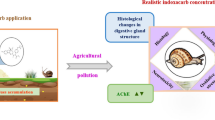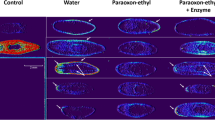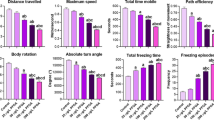Abstract
Methylmercury (MeHg+) is a neurotoxicant abundantly present in the environment. The long-term effects of MeHg+ have been investigated in rodents, yet data on the long-term or persisted toxicity of MeHg+ in invertebrates is scanty. Here, we examined the acute, intermediate, and chronic effects upon dietary administration of MeHg+ in nymphs of Nauphoeta cinerea. Besides, the potential reversibility of the toxic effects of MeHg+ after a detoxification period was evaluated. Nymphs were exposed to diets containing 0 (control), 2.5, 25, and 100 μg MeHg+/g of diet for 10, 30, and 90 days. Additional groups of nymphs were fed with the same dose of MeHg+ for 30 days and then were subjected to a detoxification period for 60 days. The nymphs exposed to 100 μg MeHg+/g succumbed to a high mortality rate, along with multiple biochemical (increase of reactive oxygen species production and glutathione S-transferase activity, as well as decrease in the acetylcholinesterase activity) and behavioral alterations. We observed delayed mortality rate and behavioral alterations in nymphs exposed to 100 μg MeHg+/g for 30 days and subsequently subjected to 60 days of detoxification. However, the biochemical alterations did not persist throughout the detoxification period. In conclusion, our results established the persistent toxic effect of MeHg+ even after a prolonged detoxification period and evidenced the use of N. cinerea as an alternative model to study the toxicity of MeHg+.











Similar content being viewed by others
References
Abnoos H, Fereidoni M, Mahdavi-Shahri N, Haddad F, Jalal R (2013) Developmental study of mercury effects on the fruit fly (Drosophila melanogaster). Interdiscip Toxicol 6:34–40. https://doi.org/10.2478/intox-2013-0007
Abolaji AO, Kamdem JP, Lugokenski TH, Nascimento TK, Waczuk EP, Farombi EO, Loreto ÉLS, Rocha JBT (2014) Involvement of oxidative stress in 4-vinylcyclohexene-induced toxicity in Drosophila melanogaster. Free Radic Biol Med 71:99–108. https://doi.org/10.1016/j.freeradbiomed.2014.03.014
Abolaji AO, Kamdem JP, Lugokenski TH, Nascimento TK, Waczuk EP, Farombi EO, Loreto ÉLS, Rocha JBT (2015) Ovotoxicants 4-vinylcyclohexene 1,2-monoepoxide and 4-vinylcyclohexene diepoxide disrupt redox status and modify different electrophile sensitive target enzymes and genes in Drosophila melanogaster. Redox Biol 5:328–339. https://doi.org/10.1016/j.redox.2015.06.001
Adedara IA, Rosemberg DB, Souza DO, Kamdem JP, Farombi EO, Aschner M, Rocha JBT (2015) Biochemical and behavioral deficits in the lobster cockroach Nauphoeta cinerea model of methylmercury exposure. Toxicol Res 4:442–451. https://doi.org/10.1039/C4TX00231H
Adedara IA, Rosemberg DB, Souza DO, Farombi EO, Aschner M, Rocha JBT (2016a) Neuroprotection of luteolin against methylmercury-induced toxicity in lobster cockroach Nauphoeta cinerea. Environ Toxicol Pharmacol 42:243–251. https://doi.org/10.1016/j.etap.2016.02.001
Adedara IA, Rosemberg DB, de Souza D, Farombi EO, Aschner M, Souza DO, Rocha JBT (2016b) Neurobehavioral and biochemical changes in Nauphoeta cinerea following dietary exposure to chlorpyrifos. Pestic Biochem Physiol 130:22–30. https://doi.org/10.1016/j.pestbp.2015.12.004
Afolabi BA, Adedara IA, Souza DO, Rocha JBT (2018) Dietary co-exposure to methylmercury and monosodium glutamate disrupts cellular and behavioral responses in the lobster cockroach, Nauphoeta cinerea model. Environ Toxicol Pharmacol 64:70–77. https://doi.org/10.1016/j.etap.2018.09.003
Arnold K, Bordoli L, Kopp J, Schwede T (2006) The SWISS-MODEL workspace: a web-based environment for protein structure homology modelling. Bioinformatics 22:195–201. https://doi.org/10.1093/bioinformatics/bti770
Assis CRD, Linhares AG, Cabrera MP, Oliveira VM, Silva KCC, Marcuschi M, Maciel Carvalho EVM, Bezerra RS, Carvalho LB Jr (2018) Erythrocyte acetylcholinesterase as biomarker of pesticide exposure: new and forgotten insights. Environ Sci Pollut Res 25:18364–18376. https://doi.org/10.1007/s11356-018-2303-9
Bastos WR, Dórea JG, Bernardi JV, Lauthartte LC, Mussy MH, Lacerda LD, Malm O (2015) Mercury in fish of the Madeira river (temporal and spatial assessment), Brazilian Amazon. Environ Res 140:191–197. https://doi.org/10.1016/j.envres.2015.03.029
Berger J (2009) Preclinical testing on insects predicts human haematotoxic potentials. Lab Anim 43:328–332. https://doi.org/10.1258/la.2008.007162
Bisen-Hersh ER, Farina M, Barbosa F Jr, Rocha JBT, Aschner M (2014) Behavioral effects of developmental methylmercury drinking water exposure in rodents. J Trace Elem Med Biol 28:117–124. https://doi.org/10.1016/j.jtemb.2013.09.008
Carvalho-Neta RNF, Abreu-Silva AL (2013) Glutathione S-transferase as biomarker in Sciades herzbergii (Siluriformes: Ariidae) for environmental monitoring: the case study of São Marcos Bay, Maranhão, Brazil. Lat Am J Aquat Res 41:217–225. https://doi.org/10.3856/vol41-issue2-fulltext-2
Chauhan V, Chauhan A (2016) Effects of methylmercury and alcohol exposure in Drosophila melanogaster: potential risks in neurodevelopmental disorders. Int J Dev Neurosci 51:36–41. https://doi.org/10.1016/j.ijdevneu.2016.04.010
Cheluvappa R, Scowen P, Eri R (2017) Ethics of animal research in human disease remediation, its institutional teaching; and alternatives to animal experimentation. Pharmacol Res Perspect 5:1–14. https://doi.org/10.1002/prp2.332
Clark JM (2018) The 3Rs in research: a contemporary approach to replacement, reduction and refinement. Br J Nutr 120:1–7. https://doi.org/10.1017/S0007114517002227
Clarkson TW (1993) Mercury: major issues in environmental health. Environ Health Perspect 100:31–38. https://doi.org/10.1289/ehp.9310031
Doi R (1991) Individual difference of methylmercury metabolism in animals and its significance in methylmercury toxicity. In: Suzuki T, Imura N, Clarkson TW (eds) Advances in mercury toxicology. Rochester Series on Environmental Toxicity. Springer, Boston. https://doi.org/10.1007/978-1-4757-9071-9_4
Dórea JG, Marques RC (2016) Mercury levels and human health in the Amazon Basin. Ann Hum Biol 43:349–359. https://doi.org/10.1080/03014460.2016.1192682
Ekino S, Susa M, Ninomiya T, Imamura K, Kitamura T (2007) Minamata disease revisited: an update on the acute and chronic manifestations of methyl mercury poisoning. J Neurol Sci 262:131–144. https://doi.org/10.1016/j.jns.2007.06.036
Ellman GL, Courtney KD, Andress JRV, Featherstone RM (1961) A new and rapid colorimetric determination of acetylcholinesterase activity. Biochem Pharmacol 7:88–95. https://doi.org/10.1016/0006-2952(61)90145-9
Habes D, Morakchi S, Aribi N, Farine J-P, Soltani N (2006) Boric acid toxicity to the German cockroach, Blattella germanica: alterations in midgut structure, and acetylcholinesterase and glutathione S-transferase activity. Pestic Biochem Physiol 84:17–24. https://doi.org/10.1016/j.pestbp.2005.05.002
Habig WH, Jakoby WB (1981) Assays for differentiation of glutathione S-transferases. Methods Enzymol 77:398–405. https://doi.org/10.1016/S0076-6879(81)77053-8
Hanwell MD, Curtis DE, Lonie DC, Vandermeersch T, Zurek E, Hutchison GR (2012) Avogadro: an advanced semantic chemical editor, visualization, and analysis platform. Aust J Chem 4:17. https://doi.org/10.1186/1758-2946-4-17
Harada M (1995) Minamata disease: methylmercury poisoning in Japan caused by environmental pollution. Crit Rev Toxicol 25:1–24. https://doi.org/10.3109/10408449509089885
Hatfield DL, Tsuji PA, Carlson BA, Gladyshev VN (2014) Selenium and selenocysteine: roles in cancer, health, and development. Trends Biochem Sci 39:112–120. https://doi.org/10.1016/j.tibs.2013.12.007
Kryger G, Silman I, Sussman JL (1999) Structure of acetylcholinesterase complexed with E2020 (Aricept®): implications for the design of new anti-Alzheimer drugs. Structure 7:297–307. https://doi.org/10.1016/S0969-2126(99)80040-9
Lang C, Kolaj-Robin O, Cirefice G, Taconet L, Pel E, Jouette S, Buda M, Milne C, Charton E (2018) Replacement, reduction, refinement - animal welfare progress in european pharmacopoeia monographs: activities of the European pharmacopoeia commission from 2007 to 2017. Pharmeur Bio Sci Notes 2018:12–36
Li P, Du B, Chan HM, Feng X, Li B (2018) Mercury bioaccumulation and its toxic effects in rats fed with methylmercury polluted rice. Sci Total Environ 633:93–99. https://doi.org/10.1016/j.scitotenv.2018.03.185
Liu H, He J, Zhao R, Chi C, Bao Y (2015) A novel biomarker for marine environmental pollution of pi-class glutathione S-transferase from Mytilus coruscus. Ecotoxicol Environ Saf 118:47–54. https://doi.org/10.1016/j.ecoenv.2015.04.012
Lovato FL, Rocha JBT, Dalla Corte CL (2017) Diphenyl diselenide protects against methylmercury-induced toxicity in Saccharomyces cerevisiae via the Yap1 transcription factor. Chem Res Toxicol 30:1134–1144. https://doi.org/10.1021/acs.chemrestox.6b00449
Magos L (1976) The effects of dimercaptosuccinic acid on the excretion and distribution of mercury in rats and mice treated with mercuric chloride and methylmercury chloride. Br J Pharmacol 56:479–484
Morris GM, Huey R, Lindstrom W, Sanner MF, Belew RK, Goodsell DS, Olson AJ (2009) AutoDock4 and AutoDockTools4: automated docking with selective receptor flexibility. J Comput Chem 30:2785–2791. https://doi.org/10.1002/jcc.21256
Mrdaković M, Ilijin L, Vlahović M, Filipović A, Grčić A, Todorović D, Perić-Mataruga V (2019) Effects of dietary fluoranthene on nymphs of Blaptica dubia S. (Blattodea: Blaberidae). Environ Sci Pollut Res 26:6216–6222. https://doi.org/10.1007/s11356-019-04133-1
Mueller GA, Soheila JM, Lars CP (2014) The molecular basis of peanut allergy. Curr Allergy Asthma Rep 14:429. https://doi.org/10.1007/s11882-014-0429-5
Naganuma A, Imura N (1984) Species difference in biliary excretion of methylmercury. Biochem Pharmacol 33:679–682. https://doi.org/10.1016/0006-2952(84)90325-3
Newland MC (2010) Fish nutrients and methylmercury: a view from the laboratory. In: Wang C, Slikker W Jr (eds) Developmental neurotoxicology research: principles, models, techniques, strategies and mechanisms. Wiley, Hoboken, New Jersey, pp 279–318. https://doi.org/10.1002/9780470917060.ch15
Nogara PA, Oliveira CS, Schmitz GL, Piquini PC, Farina M, Aschner M, Rocha JBT (2019a) Methylmercury’s chemistry: from the environment to the mammalian brain. Biochim Biophys Acta Gen Subj 1863:129284. https://doi.org/10.1016/j.bbagen.2019.01.006
Nogara PA, Farina M, Aschner M, Rocha JBT (2019b) Mercury in our food. Chem Res Toxicol 32:1459-1461. https://doi.org/10.1021/acs.chemrestox.9b00126
Oliveira CS, Piccoli BC, Aschner M, Rocha JBT (2017a) Chemical speciation of selenium and mercury as determinant of their neurotoxicity. In: Aschner M, Costa L (eds) Neurotoxicity of metals. Advances in Neurobiology. Springer, New York, New York, pp 53–83. https://doi.org/10.1007/978-3-319-60189-2_4
Oliveira C, Joshee L, George H, Nijhara S, Bridges C (2017b) Oral exposure of pregnant rats to toxic doses of methylmercury alters fetal accumulation. Reprod Toxicol 69:265–275. https://doi.org/10.1016/j.reprotox.2017.03.008
Oliveira CS, Nogara PA, Ardisson-Araújo DMP, Aschner M, Rocha JBT, Dórea JG (2018) Neurodevelopmental effects of mercury. In: Aschner M, Costa L (eds) Linking environmental exposure to neurodevelopmental disorders. Advances in Neurotoxicology, vol 2. Elsevier. https://doi.org/10.1016/bs.ant.2018.03.005
Oliveira CS, Nogara PA, Garlet QI, Rieder GS, JBT R (2019) Biological thiols and their interaction with mercury. In: CC MA (ed) Thiols: Structure, properties and reactions, 1st edn. Nova Science Publishers, Hauppauge, pp 1–60.
Pérez-Severiano F, Santamaría A, Pedraza-Chaverri J, Medina-Campos ON, Ríos C, Segovia J (2004) Increased formation of reactive oxygen species, but no changes in glutathione peroxidase activity, in striata of mice transgenic for the Huntington’s disease mutation. Neurochem Res 29:729–733. https://doi.org/10.1023/B:NERE.0000018843.83770.4b
Peterson RT, Nass R, Boyd WA, Freedman JH, Dong K, Narahashi T (2008) Use of non-mammalian alternative models for neurotoxicological study. NeuroToxicology 29:545–554. https://doi.org/10.1016/j.neuro.2008.04.006
Rand MD, Prince LM, Vorojeikina D (2019) Drosophotoxicology: elucidating kinetic and dynamic pathways of methylmercury toxicity in a Drosophila model. Front Genet 10:666. https://doi.org/10.3389/fgene.2019.00666
Rice DC (1996) Evidence for delayed neurotoxicity produced by methylmercury. Neurotoxicology 17:583–596
Rodrigues NR, Nunes ME, Silva DG, Zemolin AP, Meinerz DF, Cruz LC, Pereira AB, Rocha JB, Posser T, Franco JL (2013) Is the lobster cockroach Nauphoeta cinerea a valuable model for evaluating mercury induced oxidative stress? Chemosphere 92:1177–1182. https://doi.org/10.1016/j.chemosphere.2013.01.084
Rodrigues APC, Carvalheira RG, Gomes V, Arias ARL, Almosny NRP, Castilhos ZC, Bidone ED (2018) Acetylcholinesterase activity in fish exposed to mercury in Guanabara bay, RJ, Brazil. Environ Pollut Prot 3(4):91–99. https://doi.org/10.22606/epp.2018.34001
Ronco C, Foucault R, Gillon E, Bohn P, Nachon F, Jean L, Renard PY (2011) New huprine derivatives functionalized at position 9 as highly potent acetylcholinesterase inhibitors. ChemMedChem 6:876–888. https://doi.org/10.1002/cmdc.201000523
Rudd JWM, Bodaly RA, Fisher NS, Kelly CA, Kopec D, Whipple C (2018) Fifty years after its discharge, methylation of legacy mercury trapped in the Penobscot estuary sustains high mercury in biota. Sci Total Environ 642:1340–1352. https://doi.org/10.1016/j.scitotenv.2018.06.060
Salami AT, Odukanmi OA, Olagoke CO, Iyiola TO, Olaleye SB (2016) Role of nitric oxide and endogenous antioxidants in thyroxine facilitated healing of ischemia-reperfusion induced gastric ulcers. J Pharm Res 12:189–206
Shambaugh GF (1969) Toxicity and effects on motor coordination of some neurotropic drugs on the cockroach Nauphoeta cinerea. Ann Entomol Soc Am 62:370–375. https://doi.org/10.1093/aesa/62.2.370
Sheehan D, Meade G, Foley VM, Dowd CA (2001) Structure, function and evolution of glutathione transferases: implications for classification of non-mammalian members of an ancient enzyme superfamily. Biochem J 360:1–16. https://doi.org/10.1042/0264-6021:3600001
Silva FD, Nogara PA, Braga MM, Piccoli BC, Rocha JBT (2018) Molecular docking analysis of acetylcholinesterase corroborates the protective effect of pralidoxime against chlorpyrifos-induced behavioral and neurochemical impairments in Nauphoeta Cinerea. Comput Toxicol 8:25–33. https://doi.org/10.1016/j.comtox.2018.07.003
Stein AF, Gregus Z, Klaassen CD (1988) Species variation in biliary excretion of glutathione-related thiols and methylmercury. Toxicol Appl Pharmacol 93:351–359. https://doi.org/10.1016/0041-008X(88)90037-3
Stewart JJP (2007) Optimization of parameters for semiempirical methods v: modification of NDDO approximations and application to 70 elements. J Mol Model 13:1173–1213. https://doi.org/10.1007/s00894-007-0233-4
Streets DG, Horowitz HM, Jacob DJ, Lu Z, Levin L, Ter Schure AFH, Sunderland EM (2017) Total mercury released to the environment by human activities. Environ Sci Technol 51:5969–5977. https://doi.org/10.1021/acs.est.7b00451
Trott O, Olson AJ (2009) AutoDock Vina: improving the speed and accuracy of docking with a new scoring function, efficient optimization, and multithreading. J Comput Chem 31:455–461. https://doi.org/10.1002/jcc.21334
Vorojeikina D, Broberg K, Love TM, Davidson PW, Wijngaarden EV, Rand MD (2017) Glutathione S-transferase activity moderates methylmercury toxicity during development in Drosophila. Toxicol Sci 157:211–221. https://doi.org/10.1093/toxsci/kfx033
Waczuk EP, Wagner R, Bruna K, Rocha JBT, Ardison-Araújo DMP, Barbosa NV (2019) Assessing the toxicant effect of spontaneously volatilized 4-vinylcyclohexane exposure in nymphs of the lobster cockroach Nauphoeta cinerea. Environ Toxicol Pharmacol 72:103264. https://doi.org/10.1016/j.etap.2019.103264
Weiss B, Clarkson TW, Simon W (2002) Silent latency periods in methylmercury poisoning and in neurodegenerative disease. Environ Health Perspect 110:851–854. https://doi.org/10.1289/ehp.02110s5851
Wiederstein M, Sippl MJ (2007) ProSA-web: interactive web service for the recognition of errors in three-dimensional structures of proteins. Nucleic Acids Res 35:407–410. https://doi.org/10.1093/nar/gkm290
Zhang Y, Jacob DJ, Horowitz HM, Chen L, Amos HM, Krabbenhoft DP, Slemr F, St Louis VL, Sunderland EM (2016) Mercury transformation and speciation in flue gases from anthropogenic emission sources: a critical review. Atmos Chem Phys 16:2417–2433. https://doi.org/10.5194/acp-16-2417-2016
Funding
B.C.P. was supported by CAPES/PROEX (88882.182155/2018-01). F.D.S. was supported by CAPES/PROEX (88882.182125/2018-01). P.A.N. was supported by CAPES/PROEX (88882.182123/2018-01). O.C.O is a recipient of the 2017 CNPq-TWAS (FR no. 3240299312) Postgraduate Fellowship. MA was supported by grants from the National Institute of Environmental Health Sciences, NIEHS R01ES07331, NIEHS R01ES10563, and NIEHS R01ES020852. The authors were financially supported by the Brazilians’ development agencies: CNPq, FAPERGS/CNPq, 12/2014-PRONEX: n° 16/2551-0000, CAPES/PROEX (23038.004173/2019-93; n° 0493/2019), CAPES - Finance Code 001, and INCT-EN: For Cerebral Diseases, Excitotoxicity and Neuroprotection.
Author information
Authors and Affiliations
Corresponding authors
Additional information
Responsible editor: Philippe Garrigues
Publisher’s note
Springer Nature remains neutral with regard to jurisdictional claims in published maps and institutional affiliations.
Electronic supplementary material
ESM 1
(DOC 3239 kb)
Rights and permissions
About this article
Cite this article
Piccoli, B.C., Alvim, J.C., da Silva, F.D. et al. High level of methylmercury exposure causes persisted toxicity in Nauphoeta cinerea. Environ Sci Pollut Res 27, 4799–4813 (2020). https://doi.org/10.1007/s11356-019-06989-9
Received:
Accepted:
Published:
Issue Date:
DOI: https://doi.org/10.1007/s11356-019-06989-9




